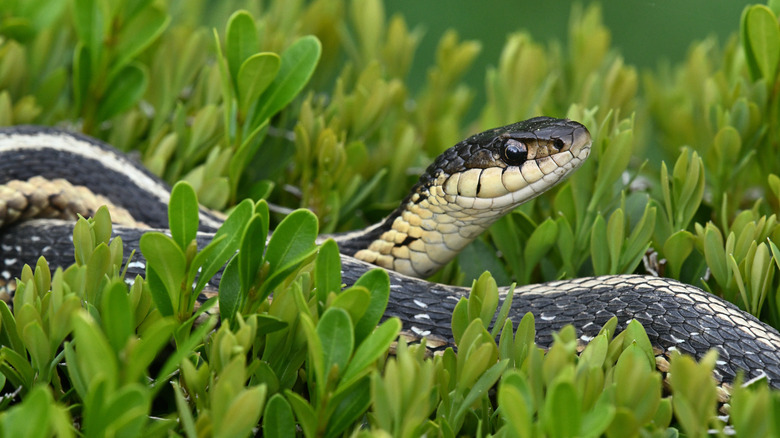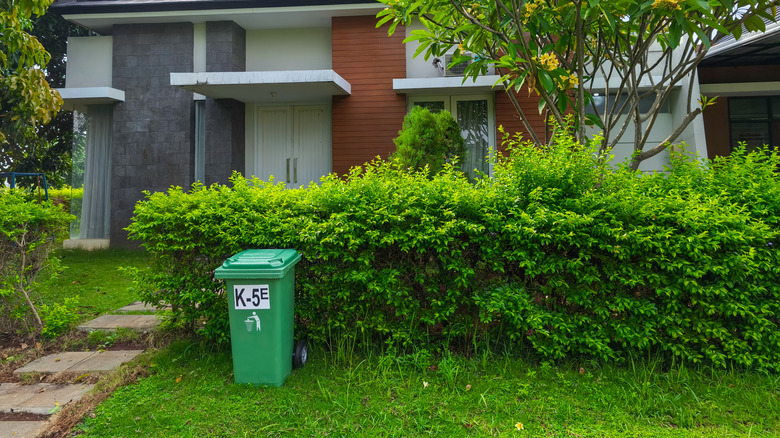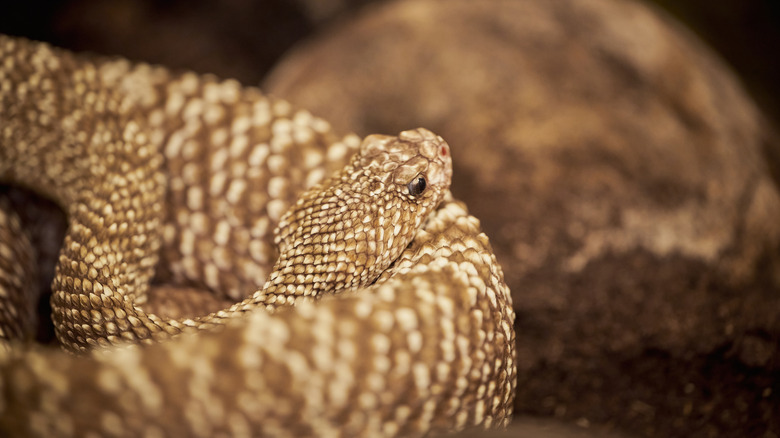The Sneaky Spot Snakes May Be Hiding In, And What You Can Do About It
Finding a snake underneath or in proximity to your outdoor garbage can, or even seeing one that got into the kitchen waste bin, can be an unforgettable shock you don't want to repeat. Outdoor trash receptacles are unfortunately a common haunt of snakes since they seek out a variety of dark, damp spots to take cover, especially toward the end of summer and start of fall. If you've been finding the slithering critters as you move the bins or take out the trash, there are various ways of encouraging the snakes to find homes elsewhere, including clearing the area of food and water sources.
Several types of snakes found around the trash, like garter snakes, lack poisonous venom and can even help your garden by eating pests, but, especially if you have young children or curious pets that play outdoors, keeping snakes out of a frequently-trafficked area like your backyard garbage is an understandable goal. With careful attention to what attracts them, you can put simple but effective ways to deter snakes into practice. It's also important to use caution and know when to contact a professional to deal with snakes that can pose more of a danger.
A key point to remember is that snakes can be helpful to your garden and local ecosystem since they tend to eat pesky rodents, and they themselves are food for other wildlife. The most environmentally friendly, not to mention safest and easiest, way to address the problem is to discourage snakes from coming near (or even entering) your trash cans rather than killing them. With that said, using store-bought snake repellant is a mistake many people make when trying to get rid of snakes. These substances are ineffective at best and toxic at worst.
Trash cans can be hideouts for snakes, but there are solutions
Why do snakes choose to nestle near trash cans when there are so many other places in the yard they could hang out? It usually comes down to one or more of the necessities they seek: food, shelter, or moisture. Shelter could be provided by the garbage bin itself, or by overgrown foundation plantings or clutter can pile up on the side of the house. All this can allow moisture to collect or small rodents to hide, which are also reasons snakes could be camping out under your deck. The best response is changing the habitat to make it unwelcome to them.
One way to make the trash can area a less hospitable space is by carefully clearing any piles of brush or weeds that may be located nearby. You don't have to throw piles of foliage away entirely, but move them away from the trash can area into a more remote part of the yard if possible. Watch your fingers, and wear protective boots or gloves while doing this. Shrubbery that has become too bushy also may need trimming. And since snakes could be coming out of firewood piles to hide near the garbage, it's a good idea to place the wood on top of an elevated rack.
Keep food attractants in check by making sure your bird feeders are far from the cans. That fallen birdseed can attract rodents, which are tasty to many snakes. Ensure that any compost or food waste is well sealed, too. The same goes for pet food; bowls of kibble for dogs or cats should stay inside. Finally, sealing any foundational cracks will help keep snakes from coming inside your home and slinking around containers there.
What do do if you see a snake, and when to call a pro
If you're surprised by a snake under or near your trash can, the first thing to do is give the critter space. Snakes naturally don't want to be near people, so staying out of range will keep you safer. Charging toward one or attempting to kill it are huge mistakes, potentially leading to snake bites or creating more of a problem if the snake had been keeping venomous snakes at bay. The snake will most likely try to slither away, so don't block any open spaces it could use to escape.
If you're able to do it from a distance, you can glimpse at the snake's markings or take a photograph to identify what type of snake it is. This will help you figure out if it's a common harmless snake or a more dangerous one. Once you know for sure, you can research what that species eats and how it typically enters a space, tailoring your response to get rid of what attracts it.
If your identification work has shown you a venomous snake is lurking near your trash, contacting a professional is the best course of action; you should never handle this type of snake by yourself. The snakes you do not want to see in your yard or near trash cans include copperheads in the eastern United States and rattlesnakes in southwestern habitats. These snakes need to be removed since their bites are very dangerous, so check with your local wildlife department right away for the next steps. Another option is contacting an organization or company that specializes in wildlife removal.


